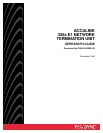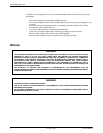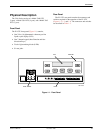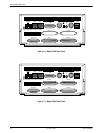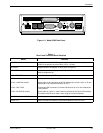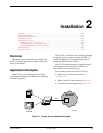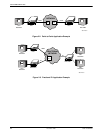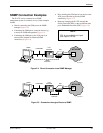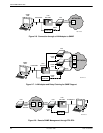
ACCULINK 336x E1 NTU
1-2 December 1996 3360-A2-GB20-20
G.703 DTE Interface
The G.703 DTE interface is compatible with the signal
format of ITU Recommendation G.703 and the frame
structure of ITU Recommendation G.704. This interface
allows DTEs/PBXs to share the network with other
high-speed equipment.
Alarm Message Capability
The E1 NTU can be attached, either locally or
remotely, to an ASCII terminal or printer to display or
print alarm messages. The communications (COM) port
can be used as the destination for Alarm Set and Alarm
Clear messages. This enables an ASCII terminal or printer
to monitor the E1 NTU for alarm conditions. Alarms can
also be displayed on a PC that is using a terminal
emulation package.
Front Panel Emulation
The E1 NTU offers functionality through Front Panel
Emulation software that is similar to that provided by the
E1 NTU front panel. The E1 NTU can either be locally or
remotely attached to a 386 or higher personal computer
(PC) that has at least four megabytes (MB) of
random-access memory (RAM). (An external modem is
required for remote attachment.) A copy of the E1 NTU
front panel appears on the PC. The functionality of the
front panel is available by clicking on the function keys
with the mouse rather than by pressing keys from the
actual front panel. For more information, refer to
Appendix G, Front Panel Emulation.
SNMP Management Support
SNMP is a network management protocol that is used
to monitor network performance and status, and to report
alarms (i.e., traps). To function, SNMP requires a manager
consisting of a software program housed within a
workstation or PC; an agent consisting of a software
program housed within a device (e.g., the E1 NTU); and a
Management Information Base (MIB) consisting of a
database of managed objects.
Users of the external SNMP manager can issue “Get”
and “Set” commands to an object in the SNMP database
maintained by the E1 NTU.
The E1 NTU can be managed by any industry-standard
SNMP manager. Paradyne provides an SNMP application
that runs on a Hewlett-Packard HP OpenView network
management platform. For more information, refer to the
ACCULINK 3100 Series Open Management Application
for HP OpenView User’s Guide.
The E1 NTU supports the following MIBs:
• MIB II – Defines the general objects for use in
Transmission Control Protocol/Internet Protocol
(TCP/IP) internets and provides general
information about the E1 NTU. MIB II is
backward-compatible with MIB I.
• DS1/E1 MIB – Defines objects for managing E1
interfaces and supports the network and G.703 DTE
interfaces on the E1 NTU.
• RS-232-like MIB – Defines objects for managing
RS-232-type interfaces (e.g., RS-422, RS-423, etc.)
and supports synchronous data ports (PORTs 1– 4)
and management communication ports (AUX and
COM ports) on the E1 NTU.
• Generic-Interface Extension MIB – An extension to
MIB II that defines additional objects for control of
generic interfaces in MIB II. It supports control of
tests on the G.703 DTE and synchronous data
interfaces that are not supported by other MIBs.
• Enterprise MIB – Defines objects that are unique to
Paradyne devices.
Two link layer protocols, Point-to-Point Protocol (PPP)
and Serial Line Internet Protocol (SLIP), are supported for
connection to an external SNMP manager or network
device (e.g., a router).
The SNMP manager or network device can be directly
connected to the communications (COM) port. An
external LAN Adapter can be connected to either the
COM port or the auxiliary (AUX) port to provide Ethernet
connectivity. Also, the E1 NTU can be daisy chained
together by connecting the COM port of one device to the
AUX port of the other, providing SNMP connectivity.
The SNMP management system can communicate to
the E1 NTU remotely through the Facility Data Link
(FDL) or (for 2-port and 4-port E1 NTUs) the
synchronous data port’s Embedded Data Link (EDL).
FDL provides an in-band channel for performance and
control signals on the network interface. It uses the spare
bit S
a4
in time-slot zero as defined in ITU
Recommendation G.704. EDL provides the ability to
detect and synchronize on a framing pattern, provides
cyclic redundancy checking (CRC), and maintains
near-end and far-end performance statistics.



